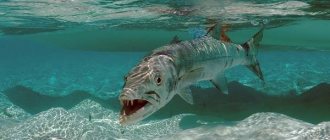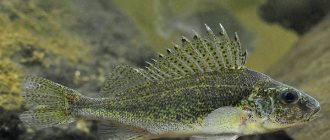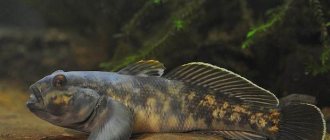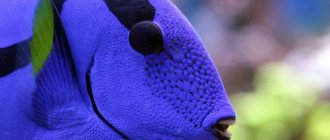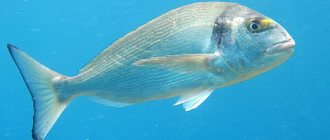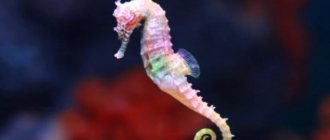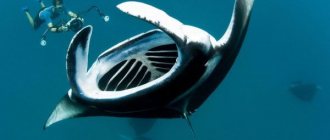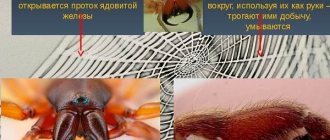Vomer is a marine fish, mysterious and not fully studied. She is nocturnal and turns invisible in the water column. Some value it for its benefits and taste, others for its beauty, embodied in silvery tints and unusual shape. What else is unique about this representative of the ichthyofauna?
| Full name | Vomer, selena (moonfish) |
| Kinds | Common, Western Atlantic, Caribbean, African, Mexican, Brevoort's, Peruvian. |
| Color | Silver with green or blue tint |
| Water | Salinity: 35 ppt, sg = 1.021-1.023 PPM (calcium): 420 ppm PH (acid-base balance): 8.0-8.3 KH (hardness): 12 t (temperature): 25-26 °C |
| Feed | Guppies, mysids, brine shrimp, shrimp, krill, pieces of seafood (squid, shellfish, etc.). |
| Compatibility | Ephippidae, plataxidae, wrasse, finfish, lionfish, rays. |
| Lifespan | Up to 10 years |
General information
The second name for vomer is selenium. It comes from the Greek “selene”, which means “moon”. Indeed, the fish has a remarkable appearance; it can become transparent or translucent under certain lighting, which resembles an Earth satellite.
Important! Selena should not be confused with the real sunfish, in Latin Mola mola.
The vomer is of limited commercial importance. During the year it is caught in small quantities, only a few tens of tons. Selenium is also popular as an object of sport and recreational fishing, and is regularly found in catches in all habitats.
Appearance
A very unusual fish of the horse mackerel family has a diamond-shaped body, strongly flattened on both sides. The color is silver-blue, the scales are small, almost invisible, and are completely absent in Pacific varieties. The mouth is sloping with a protruding lower jaw. The eyes are large, like all horse mackerel. The pelvic fins are underdeveloped, the dorsal and pectoral fins are reduced with age, turning into long, curving rays, which gives the vomer a resemblance to a crescent. The short and tall body narrows sharply towards the tail, turning into a thin stalk.
The scientific name of the fish, selene (translated from Greek as moon), is misleading and many people mistake the vomer for a variety of mola-mola. Outwardly, selenium looks like a ransania - a real moon fish, and if not for the small size of the first and the huge size of the second, they could be confused.
Yandex. Images
This is interesting: Selena is unusually thin, has almost X-ray transparency, so it merges with water and its presence can only be detected by its large eyes and yellowish tail.
Where does it live?
Vomer lives in the Atlantic Ocean and the eastern Pacific Ocean. The fish is most abundantly found off the coast of West Africa, Central America, in the California region, the waters of Ecuador and Peru, and in other frequent tropical climate zones.
For reference! Vomer is not found in Russia. Fish is imported to us from countries where they fish.
Vomer is a schooling fish. She chooses coastal waters with depths not exceeding 80 meters. Loves areas with sandy or mixed sandy-silty soil. Most often it occupies the bottom horizon, but rises into the water column and towards the surface itself.
You can often see schools of vomer mixing with related representatives of the ichthyofauna - sardinella, mackerel and bumper. Such multimillion-dollar schools attract large numbers of predatory fish and mammals.
Reproduction
In its natural environment, Selena is a very prolific fish: one clutch of a female consists of more than a million eggs. However, out of such abundance, only a quarter of the generation survives, since after throwing the eggs float freely in the water column, and neither mom nor dad are watching them.
This is interesting : the absence of the female’s instinct to care for offspring leads to the rapid adaptation of the fry to the harsh life in the ocean.
Trying to breed selenium in artificial conditions, specialists encountered a number of problems. The eggs of these fish are small and sensitive, which is why even under “ideal” conditions the survival rate was not so high. Out of 4 million eggs, only 400 individuals survived to “adolescence”. However, today breeders have developed a number of patterns, thanks to which most of the offspring survive in the clutch.
How to distinguish a female from a male
All vomer species lack sexual dimorphism. The only period when it is possible to distinguish between a female and a male is during spawning. At the moment of mating, the male will dominate. Afterwards the pair breaks up, returning to the flock. Over time, the expectant mother's belly will become rounder, and eggs with future larvae will be born.
Fry
From the eggs that are lucky to remain unharmed, larvae appear after 7-10 days. From the first hours, they search for food on their own, extracting microscopic zooplankton. Like adults, fry have the talent of camouflage: their size, translucent body and quick reaction allow them to hide from enemies without going into cover.
“Wild” selenium can live for about 7 years. Their lifespan is affected not only by predators, but also by living conditions, which sometimes change dramatically due to an unstable climate. Commercial fishing leads to a reduction in numbers: in rare cases, vomer are caught using a spinning rod with bait or a wobbler, and very often - with a seine and trawl. The level of ocean pollution also affects fish. In an aquarium, with proper care, seleniums can live for more than 10 years.
Description
Black Sea needle fish
The vomer has a flat, almost rounded body. The head is large, occupying about a third of the fish’s body. The forehead is high, steeply sloping. The mouth is small, oblique, the lower jaw is directed upward. The eyes are medium. The lateral line goes around the pectoral fin. There are no bony scutes.
The pelvic fins are very small, reduced in adults. The pectorals are located behind the gill cover. There are two fins on the back, the first one consists of 8 separately sitting spines. The tail is forked, on an elongated stem.
The body color is silver. Depending on the type of fish, it may have a bluish or olive tint. The back is darker than the belly. Particular attention is drawn to the vomer's ability to camouflage. This is achieved due to its unique structure. If you look at an individual at an angle of about 45 degrees, it almost becomes invisible. This feature allows it to better hide from the eyes of the enemy, because it has been scientifically proven that a predator attacks its prey precisely diagonally.
Diseases and prevention
Difficult living conditions have given the villagers good health and the ability to quickly adapt. Aquarium pets will not react negatively to changes in water quality, but in order for them to live as long as possible, it is necessary to monitor basic indicators. The owner may still encounter some diseases, for which he must be prepared. What can cause vomer disease?
| Disease | Symptoms | Treatment and prevention |
| White-skinned | Decreased activity, rise to the surface. White coating on the back, around the fins. Damage to the nervous system and loss of coordination. | The affected individual is placed in a separate container, levomythecin is added to the water at a rate of 200 mg per liter or special drugs according to the instructions. The main aquarium is disinfected (soil, equipment, decorations), plants are destroyed, and aeration is increased. All fish receive medicinal baths (with salt or other substances). |
| Aeromonosis | Focal inflammation (redness) of the skin, in particular on the belly, sides, and near the pectoral fins. Lethargy, lack of response. | The antibiotic bicilin-5 (500 thousand units per 100 liters) is added to the general aquarium for at least a week. Baths with chloramphenicol or methylene blue are recommended. |
| Gill rot, or branchiomycosis | Loss of appetite, rising to the surface of the water, weak reaction. The gills have stripes of pale, brown and gray colors. Afterwards - the collapse of the gill tissue and the death of the fish. | In the main aquarium, aeration is increased and 50% of the water is replaced. Fish are treated in a separate vessel with a solution of copper sulfate and specialized auxiliary means. |
| Columnaria | Light cotton wool-like spots on the head, more on the lips. Movements are constrained. The appearance of mucus on the scales. At the last stage, the fins decompose, the fish are always on the surface. | Part of the water is replaced, the level of NH4, NO2, NO3 is adjusted, aeration is increased, and the water temperature is slightly reduced. A medicine like API Furan-2, Antibak, Tripaflavin-ultra, etc. is added to the general aquarium. |
The absence of serious injury is another reason to keep a vomer-free tank. Since these fish are mobile, they can be injured when colliding with obstacles in the form of stones and decorations. Open injuries greatly increase the chance of contracting a bacteria or fungus.
Vomers attract both amateurs and aquarium professionals with their unique appearance. Now you too have become more familiar with this unique fish.
Is it worth spending so much effort and money on such a pet, or is it better to stick with something simpler? Write your opinion in the comments.
Behavior
The vomer is most active after dark. During the daytime, he likes to rest in the near-bottom horizon. Juvenile fish often enter river mouths into fresh water. Adults prefer the open sea, but try not to go more than 100 meters from the shore.
The basis of the womer's diet is bottom invertebrates. These can be shrimp, crustaceans, crabs, sea worms. However, adult individuals that have reached sizes close to maximum willingly eat small fish, although they are not considered pronounced predators.
Womer spawns near its places of residence. It lays its eggs on the sandy bottom, so the eggs mature in the water column, since they are not attached to anything.
Vomer stays in packs
They are actively eaten by other representatives of the ichthyofauna, which explains the low survival rate. However, nature has taken care of preserving the species - Selena females are very fertile, and after birth, the young are immediately able to feed on the smallest zooplankton on their own.
Are they kept in aquariums?
First of all, vomer is a commercial fish. If she lives in artificial conditions, then most often it is a special farm. Selena is also a decoration for oceanariums and zoos with an underwater kingdom. What about keeping such a fish at home?
Those who are going to buy a live vomer as a pet should take into account the volumes necessary for a comfortable life for the fish. For a small young group a 500 liter tank will be fine, but as they grow up this should be upgraded to a 3400 liter tank. The habitat should not be cluttered with large stones, corals, or decorative items. The only thing that can be marked besides the flat ground is a few seaweeds near the walls. All these requirements are due to the fish’s love for active movements.
This is important : Selena is a schooling fish, so keeping it alone will not work. The minimum number of individuals in a group is 5 pieces.
It is worth noting that vomeras are peaceful, so you can add other species that also prefer open space (for example, some of the ephippidae and plataxidae). Also suitable as neighbors are stingrays, lionfish, longfins, some burrows and wrasse.
Finding food for selenium is also not difficult. Young fish will happily feast on guppies, mysids, and brine shrimp. Older ones - shrimp, krill, pieces of squid or shellfish.
Varieties
Today, ichthyologists identify seven species, four of which live in the Atlantic Ocean, and three in the Pacific. In appearance, these fish differ somewhat from each other, especially at a young age, in the shape and size of the dorsal fin.
So, there are the following types of vomer:
- common selenium, Selene vomer - inhabits the waters of the western coast of the Atlantic Ocean, from Canada to Uruguay;
- Western Atlantic selenium, Selene setapinnis, is native to the entire western Atlantic coast, from Canada to Argentina.
- Caribbean sunfish, Selene brownii - lives in the waters of the Atlantic Ocean from Mexico to Brazil;
- African sunfish, Selene dorsalis - found in large numbers along the east coast of the Atlantic, from Portugal to South Africa;
- Mexican Selena, Selene orstedii - lives along the east coast of the Pacific Ocean, from California to Mexico;
- Selene Brevoortii - found in the Pacific Ocean from Ecuador to Mexico;
- Peruvian Selena, Selene peruviana - found from California to Peru.
For reference! West Atlantic selenium is the largest among the vomerians. Grows up to 60 cm in length.
The latter is of greatest commercial importance and is caught in large numbers off the coast of Ecuador. The high demand for this fish in Eastern Europe has led to its overfishing and, as a result, a decline in population.
Aquarium giants
The intelligence and character of large fish are often the reason why they are kept in home aquariums.
Piranhas
Predators of water bodies in South America - piranhas in nature can grow up to 80 cm. In an artificial environment, when optimal conditions are created, their size reaches 30 cm. An adult piranha has a silver-olive color with a purple tint. A distinctive feature of the species, of course, is the jaws and sharp teeth with which the fish tears out pieces of flesh from its prey. The teeth are razor-sharp and durable. With them, a fish can bite a human finger. Piranhas are so voracious that they attack prey that is tens of times their size. A school of piranhas can even attack a crocodile. About 10 species are bred in the aquarium. The most common is the common or red-bellied piranha.
Shark catfish
This species of fish, better known as pangasius, is one of the largest that is bred in aquariums. Under natural conditions, pangasius grows up to 1.5 meters, in an artificial environment - up to 60-80 cm. Due to its external resemblance to a shark, pangasius is also called a freshwater or pennant shark. The shark catfish grows very quickly and is extremely voracious. This is a very shy fish. Pangasius is afraid of everything and, in case of panic, can even faint, which lasts up to 20 minutes. Big fish require a big aquarium. Very often, due to the rapid increase in size, shark catfish outgrow their aquariums.
Shelled pike
One of the largest armored fish is the spotted pike, whose length in natural conditions reaches 1.2 meters. The distribution area is the rivers of North America flowing into the Gulf of Mexico.
The size of the armored pike in the aquarium depends on the conditions of detention and the dimensions of the tank. In a small container, pike stops growing. Pike behaves very aggressively towards other inhabitants of the aquarium. Therefore, most often large individuals are kept in a species-specific demonstration aquarium.
For its long powerful jaws, the pike received another name - “alligator fish”. Its metallic-colored body is covered with dark spots and very hard, tile-shaped scales. Armored pikes live up to 18 years.
Ocellated Astronotus
One of the largest fish kept in the aquarium is Astronotus, common in the Amazon basin. But now this species is also bred in Asia, it is especially popular in Thailand. Astronotus is also known by other names: “water buffalo”, “peacock eye”, “Oscar”. The general color can be gray, brown or even black, with yellow spots scattered throughout. The caudal fin is decorated with a black spot with an orange border, similar to an eye. The most popular among aquarists is the artificially bred form with a red body and white fins. The peacock eye is a very gentle pet. He can allow himself to be stroked, but when he senses danger, he is capable of biting with his small sharp teeth. It quickly gets used to people and can feed from hands. When good conditions are created, astronotus reaches its maximum size of 35 cm by the fourth year of life.
Beneficial features
Vomer meat has a low fat content, about 4%, and a high percentage of protein, under 20%. It also contains a sufficient amount of phosphorus and calcium. Therefore, this fish often appears in the diet of athletes, especially in strength sports such as bodybuilding, weightlifting, powerlifting, arm wrestling and others.
Advice! There are definitely benefits from using fish, and especially lean vomer meat, rich in protein!
Smoked vomer is an incredibly tasty dish, especially with beer.
In order to preserve all the beneficial microelements and components of vomer meat as much as possible, it is advisable to bake it in the oven or cook it on the grill. In addition, residents of Ecuador, Peru and other South American countries love to fry selenium, as evidenced by numerous recipes from the peoples of this region.
In our country, vomer is best known as a beer snack. It is served dried, dried, and less often smoked. In terms of its gastronomic qualities, it can compete with the famous vobla and saberfish. You can try the fish fried or baked in a restaurant.
Smoking methods
Smoked vomer is a real delicacy that no one can resist. The meat of this fish is very tender. The finished smoked meats are aromatic, regardless of how the smoked meats are prepared.
Carcass preparation
Before you start smoking, you need to prepare the product. First, it defrosts. You cannot use any special devices to speed up defrosting, as this will negatively affect the taste of the finished product.
Be sure to wash thoroughly, then remove the insides. You should not cut off the head, because then smoking the fish will be inconvenient.
Cold smoking
Is vomer poisonous?
There are many misconceptions about vomer. One of them is that these fish are considered poisonous. However, there are still no facts confirming this information. Therefore, selenium can be eaten without restrictions.
***
Vomer is a very interesting sea fish. It attracts attention both with its appearance, which is immediately memorable, and with its high taste. And although this underwater inhabitant does not live in our reservoirs, all fishermen, especially beer lovers, know about it.
